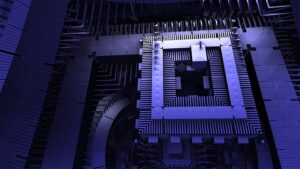
Quantum Computers
What is Quantum Computing?
Quantum computers are influencing a replacement generation of simulations already running on classic computers, but are now accelerated by the NVIDIA quantum SDK.
Twenty-seven years before Steve Jobs introduced a computer that he could carry in his pocket, physicist Paul Benioff had how more powerful system, yet sufficiently small to hide in his fingertips. , Announced during a paper that it’s theoretically possible to make a robust system, a quantum computer.
The SDK takes an independent approach, allowing users to choose the tool that the majority accurately fits their approach. as an example, the state vector method gives hi-fi results, but its memory requirement grows exponentially in proportion to the number of qubits.
A newer approach, tensor network simulation, can perform similar tasks with less memory and more computation.
“With improved performance and straightforward use, NVIDIA hopes that cu Quantum is getting to be a cornerstone of all the leading quantum computing frameworks and simulators during this area of research.
Benioff’s concept, written in 1980, seeks to utilize high-energy physics and is understood as after this discipline. this is often often often often still being enthusiastically researched, and efforts are being made to make subsequent major innovation in computing: a system that makes the PC abacus-like.Quantum computers use qubits, which are units of measure that allow you to use on, off, or any value in between, instead of the on or off, 1 or 0 bits utilized in traditional computers.
Quantum Computing Function
This is a function like multiprocessing in computing. All possibilities are calculated directly rather than sequentially, resulting in significant speedups.
Thus, quantum computers have the potential to reshape the entire field, like cryptography, which is based on the factorization of numbers that are currently impossible.
The big role of a little simulation is just the beginning. Some experts are convinced that quantum computers will break through the bounds that are currently hindering the simulation of worlds built on nano-sized physics, like chemistry and materials science.
Some people have Quantum computers could even extend the lifetime of semiconductors by allowing engineers to form more sophisticated simulations of the quantum effects that are currently being discovered with the tiniest transistors.
The function of qubits within the intermediate state is known as “superposition”, which adds a robust function to computing equations and makes quantum computers superior in some mathematical fields.
What does a quantum computer do by using qubits, quantum computers can easily perform calculations that may take an extended time, albeit they could be completed on a classical computer. For example, today’s computers use 8 bits to represent any number between 0 and 255. For quantum computers, features like superposition can use 8 qubits to represent any number between 0 and 255 “simultaneously”.
How Quantum Computing Works. Don’t expect to be ready to build your quantum computer, slightly like DIY a PC with a gaggle of parts sold for disposal at an area electronics store.
Very few systems are currently operational and typically require refrigeration facilities which can create an operating environment with temperatures on the brink of temperature. handling the fragile quantum states that drive these systems requires a “polar” environment for computing. Quantum computing uses very powerful nano-sized forces to form a condition called “entanglement.” this is often often often a condition during which two or more qubits exist during one quantum state, which can be observed by electromagnetic waves as wide as 1 millimeter.
If you add an excessive amount of energy to the electromagnetic waves, you lose the state of entanglement, superposition, or both. the result is a loud condition called decoherence. this is often often often the “blue screen” in quantum computing. These systems provide dozens of qubits, which can be noisy and unreliable. To be reliable in handling real-world problems, systems require tens or many thousands of qubits. Experts believe that it will take decades for quantum computers to understand an era of truly useful hi-fi.
Using this method, NVIDIA and thus the California Institute of Technology have accelerated state-of-the-art quantum circuit simulators with cuQuantum running on NVIDIA A100 Tensor core GPUs. We then generated a sample on Selene from a full circuit simulation of the Google Sycamore circuit in 9.3 minutes. this is often often often often a task that experts expected a year and a half ago to wish days with many CPU cores.
Tensor Network – 53 Qubits, Depth m = 20 | CPU: Quimb on Dual AMD EPYC 7742 (Estimated) | GPU: Quimb on DGX-A100 Johnnie Gray, an inquiry scientist at the California Institute of Technology, said: “Using the Cotengra / Quimb package and NVIDIA’s newly announced cuQuantum SDK and Selene supercomputer, we generated a sample of a Sycamore quantum circuit with a depth of m = 20 at record speed in but 10 minutes.” Garnet Chan, a professor of chemistry at the California Institute of Technology and a professor within the laboratory that hosted the study, said: “This sets a benchmark for the performance of quantum circuit simulation. The improved ability to verify the behavior of quantum circuits will further advance the earth of quantum computing.
Quantum computers are slowly moving towards commercial use. Predicting when quantum computing is getting to be able to do things that traditional computers couldn’t do, the so-called “hegemony,” is currently being actively debated within the industry.
Accelerate current quantum circuit simulation good news here is that the earth of AI and machine learning is watching accelerators like GPUs which may perform many of the kinds of operations that quantum computers do with qubits.
As a result, even classic computers are now finding ways to use GPUs to host quantum simulations. as an example, NVIDIA ran state-of-the-art quantum simulations on its in-house AI supercomputer, Selene. At the GTC keynote, NVIDIA announced the quantum SDK, which accelerates quantum circuit simulations running on GPUs. Early studies have shown that quantum is predicted to deliver orders of magnitude faster.






